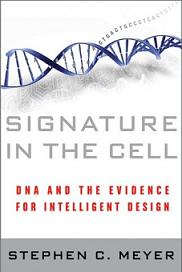
Stephen C. Meyer has published a (very long, but readable) book, Signature in the Cell: DNA and the Evidence for Intelligent Design,
outlining his argument in favor of intelligent design. Chapter 15 is where we finally get to the point. The groundwork has been laid, and Meyer explains why he thinks that intelligent design is the best explanation for the origin of life – and more specifically, the origin of the specified information required for life. Today we will look at Meyer’s argument, on his terms, and ask a simple question:
Is Meyer’s case for Intelligent Design convincing? Does he achieve his goal?
Meyer wishes to establish the causal adequacy of Intelligent Design for the information content in DNA, to demonstrate that inference to best explanation leads to an intelligent designer.
I knew that in order to establish a cause as the best explanation, the historical scientist must do more than establish that a proposed cause could have produced the effect in question. He must also provide “evidence that his candidate [cause] was present.” and show via “a thorough search” that there is an “absence of evidence” of “other possible causes”. In other words, in addition to meeting a “causal adequacy” condition, a best explanation must also meet a “causal existence” an/or “causal uniqueness” condition. (p. 329)
He also claims that “in practice, meeting the third condition (causal uniqueness) effectively ensures that the second condition (causal existence) will also be met.” (p. 329)
Meyers puts forth the argument that (1) there is no other possible cause for the information content of the cell and (2) that the unique cause for specified information is intelligence. Because intelligence is a unique cause, he does not need to prove causal existence – the existence of a designer. The existence of information proves the existence of a designer.
How does Meyer construct the argument?
Reason 1: No Other Causally Adequate Explanation
The previous few chapters of Meyer’s book set up his argument on this point – that there is no “natural” causally adequate explanation for the origin of life, specifically for the origin of the specified information required for life. The discussion of the RNA world hypothesis and other potential scenarios for the origin of life are essential for this point.
Meyer suggests that:
(1) … self-organizational laws or processes of necessity cannot generate – as opposed to merely transmit – new information. (p. 331)
(2) “[Theories based on chance] fail because of an inherent limitation in the probabilistic resources of the universe itself.” (p. 331)
(3) Theories that combine chance and necessity fare no better:
Since natural selection “selects” for functional advantage, and since functional advantage ensues only after the result of a successful random search for functional information, combination models invariably rely upon chance rather than selection to produce new information. Yet these theories face formidable probabilistic hurdles, just as pure chance-based models do. (p. 331)
I think that Meyer’s argument fails on the third point – it is possible to envision and construct theories based on chance and necessity, that lead inevitably from lower complexity (less information) to greater complexity (more information). These models do not run into essential (i.e. unavoidable) probabilistic hurdles, although the kind of probabilistic arguments discussed in our earlier post (Signature in the Cell 4) place limits on reasonable explanations. Meyer has a response for such models though:
Every attempt to explain the origin of biological information either failed because it transferred the problem elsewhere or “succeeded” only by presupposing unexplained sources of information. The displacement problem was particularly evident in computer simulations where positive results depend so obviously on the input of information from intelligent programmers … (p. 332)
This leads to Meyer’s second reason for suggesting that an intelligent designer is the best explanation.
Reason 2: Experimental Evidence Confirms Causal Adequacy of ID
Intelligence can produce life (or at least elements of life). According to Meyer his investigation into origin of life research, and particularly what he calls “the DNA enigma” led to positive experimental evidence for intelligent design.
This evidence did not come from weird attempts to detect the paranormal or supernatural. Instead the evidence came from experiments that pointed to a normal, at least to us, causal power – in particular the power of our own minds. The experiments inadvertently demonstrated not only the power of mind over matter, but also the necessity of a mind to arrange matter into structures relevant to life. (p. 333)
Meyer argues that all of the experiments in origin of life research from Miller’s original prebiotic simulation experiments to produce amino acids, to computer simulation experiment testing evolutionary algorithms, to the ribozyme engineering experiments of Szostak and others, demonstrate the key role played by a designer in the origin of life. Life will only originate if the correct conditions are engineered and this can be achieved by intelligence (intelligence is causally adequate).
Beyond a statement of the adequacy of intelligence, this appears to be an argument about primary cause versus secondary cause. Meyer argues that experiments that elucidate secondary causes only relocate the primary cause. The intelligence required to engineer investigations of secondary cause provides evidence that the primary cause is an intelligence. This is an argument that many Christians may agree with, although likely disputing some of the points Meyer makes in trying to demonstrate it.
Reason 3: ID is the only known cause of specified information
Undirected materialistic causes have not demonstrated the capacity to generate significant amounts of specified information. At the same time, conscious intelligence has repeatedly shown itself capable of producing that information. (p. 341)
Meyers notes that arguing from effect to single known cause is a common form of reasoning. The presence of volcanic ash demonstrates past volcanic activity, evidence of erosion on Mars is taken to demonstrate that Mars once has significant amounts of water on the surface. Taking this one step further:
Archaeologists assume that a scribe produced the inscriptions on the Rosetta Stone. Evolutionary anthropologists establish the intelligence of early hominids from chipped flints that are too improbably specified in form to have been produced by natural causes. NASA’s search for extraterrestrial intelligence (SETI) presupposes that any specified information embedded in electromagnetic signals coming from space would indicate an intelligent source. As yet, radio astronomers have not found any such information-bearing signals. But closer to home molecular biologists have identified information-rich sequences and systems in the cell, suggesting, by the same logic, the past existence of an intelligent cause for those effects. (p. 344)
With this argument Meyer brings his argument of intelligence as primary cause one step further. I interpret his argument here to state that intelligence must be the primary cause of the complexity of specified information in the cell – the primary intelligence did not use secondary cause to create the information. An intelligence constructed the information content recorded on the Rosetta Stone, an intelligence constructed the information content in cave paintings found in Lascaux France (ca. 16000 years old) and the information content in the 30000 – 40000 year old Aurignacian figurines found in Germany. Meyer suggests that the evidence indicates that in the same way an intelligence constructed the information content contained in the DNA of the first cell.
Where does this leave us?
I put forth the following and then we start a conversation.
Meyer has not demonstrated that intelligence as direct primary cause is responsible for the information content of the cell.
He fails on causal uniqueness. His arguments against the plausibility of “natural” mechanisms are not convincing. At most he has provided an argument for a primary cause behind the secondary causes that lead to the information content of the cell. His arguments against information in DNA or RNA as accident remembered (pp. 277-279 and p. 312-317) essentially concede this point (although he does not admit it). The intelligence is displaced to something in the design of the environment within which the specific information grows. This is a position with which many Christians are comfortable – including at some level Simon Conway Morris (Life’s Solution), Owen Gingerich (God’s Universe), Alister McGrath (A Fine-Tuned Universe), John Polkinghorne (Quarks, Chaos & Christianity), Francis Collins (The Language of God), and Tim Keller (The Reason for God).
Meyer may also fail on causal adequacy because he has not even suggested, much less presented evidence supporting, a plausible mechanism for the transfer of information from immaterial intelligence to a material system – say the DNA of the first cell. If we argue by analogy with human experience, as Meyer proposes, transfer of information from the mind of the scribe to the Rosetta Stone required arms, hands, and tools. The intelligence of early hominids used muscles, hands, and tools to produce chipped flints. How does an immaterial intelligence produce information in a material system?
What do you think? Did Meyer make his case on causal adequacy or causal uniqueness?
If you wish to contact me, you may do so at rjs4mail[at]att.net

